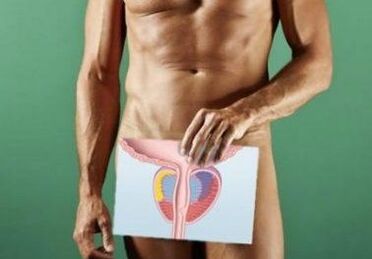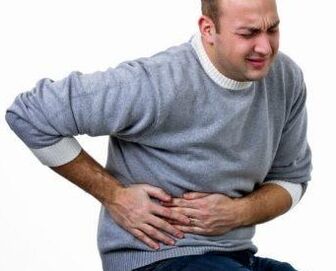The inflammation of the prostate gland is a serious illness that can lead to serious consequences if it is not.The prostate is under the bladder.
When inflamed, it increases significantly in size, blocking the bladder's neck and interfering with the urine outlet.Therefore, with the first symptoms and manifestations, it is necessary to immediately contact a specialist to identify and begin the treatment of prostatitis.

The main symptoms: How does prostatitis manifest?
Previously it was believed that this is an adult disease and older men, but in modern living conditions (ecology, food quality, fashion, a negligent attitude of young people for their health, constant car movement, etc.), the inflammation of the prostate gland is significantly "younger."
The incidence of young people under 18 is 5%, from 18 to 30 years - 45%, from 30 to 50 years - 20%, more than 50 years - 30%.This suggests that it is necessary to follow male health and listen to the symptoms from an early age.
There are several types of prostatitis in the form of manifestation (chronic, acute) and by the type of inflammation (bacterial, stagnant, purulent, infectious, calcous).The symptoms of the disease can be different, depending on the type of inflammation of the prostate gland in men.
Acute prostatitis symptoms:
- Poor good: weakness, chills, fever).A person can start throwing in heat or cold.General symptoms resemble the manifestation of SAR or influenza;
- a strong increase in body temperature to the subfubbrille brand (37.5-38 degrees) and higher;
- Severe cut, sewing pains in the perineum (groin area, anus, etc.);
- Lumbar pain, hips, give legs, knees, feet or leg muscles;
- acute pain that appears during the act of defecation and to tension;
- Urination problems (insufficient / frequent urination, painful or difficult to urinate).Urine delay for a long period of time (more than 12 hours);
- deterioration of sexual function (weak or complete erection, ejaculation, conception problems);
- Genital development (in the most serious and advanced cases of prostatitis).
Chronic prostatitis symptoms:
- Urine problems (difficult urination, pain, insufficient urine, a sensation of incomplete emptying of the bladder, etc.);
- Unpleasant pain and sensations in the crotch, between the legs, in the groin, in the anus.Pain syndrome is not pronounced;
- In the groin, sometimes acute pain or a strong ardor feeling, becoming the crotch;
- General discomfort during a long period (drowsiness, apathy, depressive state, constant fatigue, muscle weakness, etc.);
- nervousness, irritability;
- A slight increase in body temperature.Sometimes, a subfebril temperature can remain for a long time;
- Decreased sexual function (problems with erection, decrease or lack of ejaculation, decreased libido, infertility, etc.).

The chronic course of prostatitis implies periods such as remission and relapse.During relapse, the symptoms in a chronic way can become symptoms in an acute way of the disease.
Bacterial symptoms:
- signs of the inflammatory process (heat, fever, fever, general weakness, pain syndrome in the muscles and bones);
- Signs of local inflammation of the prostate (pain in the perineum, groin, anus);
- problematic urine;
- Change the consistency, color and smell of liquids (urine, the secret of the prostate, sperm, blood).
Calculation symptoms:
- Weak and moderate pain syndrome in the lower back, Sacra section, crotch, anus;
- Pull pain and burning in the perineum, groin;
- Pain intensifies significantly after sexual relations and during active movement;
- Urine problems, a sensation of burst of the bladder;
- decrease in libido, problems with ejaculation and erection (to erectile dysfunction);
- In advanced cases, drops of blood may appear on sperm (it becomes light or bright red).
Symptoms in a stagnant way:
- Constant unpleasant sensations in the groin area, crotch and anus;
- Periodic pain in the perineum;
- Problematic urine, a feeling is not completely inanis of the bladder;
- constant temperature increase to the subfebrile brand;
- Manifestations of the general inflammatory process in the body (increase in ESR, discomfort, drowsiness, fatigue, headaches, weakness, muscle pain, etc.);
- Problems in the genital area (weak ejaculation and erection, infertility);
- Nervous conditions, depressive state, apathy.
Symptoms in an infectious way:
- signs of inflammation in the body (greater value of the ESR in the blood of a man, muscle pain, fever);
- pain of pain in the lower back, groin and perineum;
- pain during defecation;
- acute pain in groin and perineum;
- Problems with urination (difficult, rapid urination, lack of urgency, etc.).
Purulent form symptoms:
- a strong strong increase in body temperature (above 38, 5 degrees);
- signs of the inflammatory process in the body (high value of ESR, muscle pain, heat, chills, etc.);
- Pain syndrome pronounced in the groin, perineum and anus;
- acute pain in the perineum;
- Difficult urine, painful urine;
- Purulent discharge from the genitals.
What are the first signs of men?
With the initial inflammation of the prostate in a man, only part of the symptoms of the disease can only happen.Signs of the initial inflammation of the prostate, which must pay special attention to:

- unpleasant sensations in the perineum;
- Periodic pain of weak pull in groin and perineum;
- pulling unpleasant sensations in the anus and the intestines during defecation (in the absence of hemorrhoids);
- long -term general discomfort, not related to SAR, tonsillitis, influenza and other colds;
- decrease in libido, malfunction during ejaculation and erection (its periodic absence);
- decrease in the quality of orgasm;
- unpleasant sensations in the urethra and in the groin during sex or after sexual intercourse;
- change of consistency, color and sperm smell;
- Improvement of body temperature.
Expressed signs of acute prostatitis:
- an increase in temperature to 37.5-40 degrees without apparent reason (not a cold, no flu, not angina);
- The urine frequency increases 3-4 times and is accompanied by acute pain.Urine flows slowly and with weak pressure;
- Burning in groin, perineum and during defecation.Intestine pain during defecation act;
- Discharge of intestine or urethra pus (with severe course and purulent form of the disease).
Pronounced signs of chronic prostate inflammation:
- burning in groin and perineum.Ardor in the genitals (especially when urinating and sex);
- Purulent discharge of the urethra after urine and forcing (active movements or defecation).Purulent discharge of the rectum;
- nervousness, depressive states, irritability;
- Fast fatigue for no apparent reason, drowsiness.
Pain syndrome for inflammation of the prostate gland
Almost always, with the inflammation of the prostate gland, a man can discover the causes of pain syndrome by his character.Characteristic pain, pain, pain or acute appear in the crotch and groin.Acute or relapted in the chronic form of pain, pain is characterized as acute, sharp, strong, cutting and pull pain.In the chronic form of the disease, pain is newspaper, similar to wave.In addition, pain syndrome can be weak, but constant.The inflamed prostate gland presses the urethra, the bladder's neck and its ureters.It is in these channels that urine comes out of the bladder, from which pain can appear during urine.In addition, pain during urination can be a sign of bladder infections or genitourinary system (sexually transmitted diseases).
Accompanying pains can have a completely different cause of occurrence.As well as the presence of several pains that accompany prostatitis may not be the inflammation of the prostate gland, but by a set of other diseases.
Other causes of accompanying pain:
- Abdominal pain is a symptom of many other diseases.A surprising example is appendicitis, acute poisoning, intestinal infection or interrelation.
- The lower back can hurt due to hernia, osteochondrosis, the pinch of nerve endings, osteoporosis, sclerosis dispersed and other diseases of the spine.
- The pain in the anus can occur due to hemorrhoids, cracks, bruises, a long sitting on an uncomfortable solid surface and several neoplasms (benign or malignant).
- Sacred column pain syndrome is more serious.Most of the time they are problems with bones, vertebrae and discs (osteochondrosis, osteoporosis, displacement, pinch, etc.).

Sometimes, pain in the sacrum means problems with other internal organs (kidneys, intestines, bladder and ureter), gynecological diseases, thrombophlebitis, inflammation of pelvic organs.
- Leg pain can mean a manifestation of flat feet, thrombophlebitis, atherosclerosis, varicose, arthritis, osteoporosis, inflammation of the sciatic nerve and even diabetes.Leg pain can have many different reasons.
The most common is the fatigue of the legs and muscles of prolonged physical activity.
What specialist is dedicated to the treatment of the disease?
In the patient, only a qualified doctor is diagnosed in the patient, a urologist.Collect an anamnesis and examine the patient.Then he directs the evidence to man (PSA-antigen-protein to detect prostatitis) and an ultrasound of pelvic organs.
In addition, the patient without fail passes the general blood and urine tests.According to the results of all analysis, the urologist can accurately determine the diagnosis and the form of inflammation of the prostate gland.Only after these procedures, the doctor can prescribe an individual treatment course, including medications, antibiotics and other medications that generally take houses.
A man in 95% of cases knows exactly what diagnosis the urologist will do, because the pain with inflammation of the prostate is very specific.It is necessary to constantly listen to your body, monitor all the changes that occur with the body.This is the only way a man can maintain his male health for many years.Careless prostatitis threatens not only a urine disorder, but also with problems with libido, ejaculation, an erection, which can finally lead to infertility.













